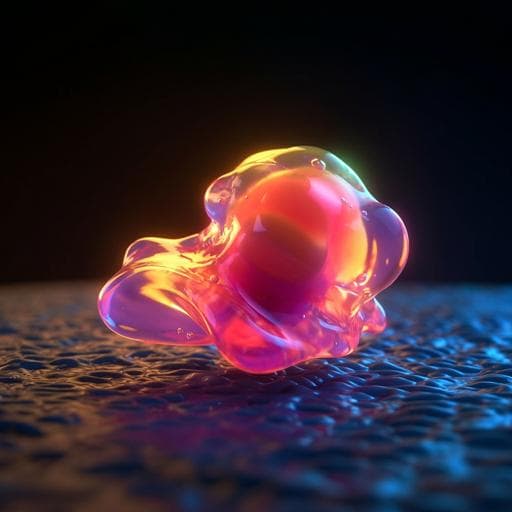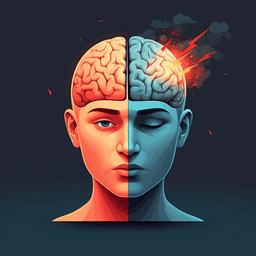
Engineering and Technology
Light-steered locomotion of muscle-like hydrogel by self-coordinated shape change and friction modulation
Q. L. Zhu, C. Du, et al.
This exciting research led by Qing Li Zhu and colleagues reveals a groundbreaking biomimetic soft robot crafted from hydrogel that responds to light to perform various movements including crawling and walking. This innovative approach opens new avenues for advanced soft robotics.
~3 min • Beginner • English
Introduction
The study addresses how to realize versatile, controllable locomotion in soft robots without relying on multiple independently actuated components. Biological systems coordinate anisotropic muscles to traverse complex terrains; emulating this in synthetic systems remains challenging. Conventional hydrogel actuators often require environmental heating, ratcheted substrates, asymmetric geometries, or multiple actuators, limiting speed, programmability, and efficiency. The authors hypothesize that an anisotropic, muscle-like hydrogel that exhibits rapid, reversible, isochoric deformation, combined with dynamic modulation of surface friction, can enable light-fueled, programmable locomotion. The purpose is to design, fabricate, and control hydrogel-based soft robots that leverage spatiotemporal light stimuli to coordinate localized deformation with frictional anchoring, achieving biomimetic gaits such as crawling, walking, and turning. This approach aims to expand the capabilities of continuum soft robots with high spatiotemporal control and potential for miniaturization.
Literature Review
The work builds on soft robotics and responsive materials literature demonstrating bioinspired locomotion and transformations using stimuli such as heat, light, and fields. Prior studies include soft actuators and robots employing liquid crystal elastomers, magnetic domains, photothermal effects, and patterned gels to achieve undulation, peristalsis, or buckling. Anisotropic hydrogels with cofacially aligned nanosheets are known to exhibit electrostatically driven, thermoresponsive anisotropic deformation via permittivity switching near the LCST of PNIPAAm. Light-driven soft microrobots and films have shown swimming and wave generation, while hydrogel-based locomotion often relies on ratchet substrates, geometric asymmetries, or external constraints. The present study integrates electric-field-induced nanosheet orientation with photolithographic patterning and AuNP-based photothermal heating to achieve rapid, localized actuation and friction modulation, addressing limitations in speed, selectivity, and control reported previously.
Methodology
Materials and components: N-isopropylacrylamide (NIPAAm) monomer, N,N'-methylenebis(acrylamide) (MBAA) crosslinker, LAP photoinitiator, fluorohectorite nanosheets (Na0.5[Li0.5Mg2.5][Si4]O10F2), and gold nanoparticles (AuNPs) synthesized per literature protocols. Millipore water used throughout.
Preparation of nanosheet (NS) suspensions: Fluorohectorite powder was dispersed in water and oscillated at 60 rpm for 3 months at 25 °C to achieve osmotic delamination into single-layer NSs.
Electric-field-induced orientation: NS aqueous suspension was loaded into a glass cell (parallel plates, 2 mm or 1 mm silicone spacer depending on step). An AC high-frequency electric field was applied using Ag electrodes separated by a set distance (20 mm for gel synthesis), aligning NSs along the field.
Synthesis of monodomain nanocomposite hydrogels: Precursor solution contained NIPAAm, MBAA, LAP dissolved in NS suspension (NS ~0.27 wt%). After electric-field alignment, the cell was UV-irradiated for 30 s to polymerize/crosslink PNIPAAm, locking NS orientation. For photoresponsive gels, AuNPs (~0.013 wt%) were incorporated prior to alignment and polymerization. Gels were swollen in excess water for days to remove residuals and equilibrate.
Patterned anisotropic hydrogels: Multi-step orientation and photolithography were used. After initial NS alignment, UV exposure through an inkjet-printed photomask polymerized exposed regions. Unpolymerized regions were reoriented under a second electric field with different direction (1 h), followed by UV exposure without mask to polymerize and fix the reoriented domains. Patterns included stripes at prescribed angles and checkerboards with orthogonal NS alignments. Resulting patterned gels were equilibrated in water.
Actuation protocols: Thermally triggered actuation by transferring gels between 25 °C and 40 °C water baths; and photothermal actuation using 520 nm green light. Local temperature rise was controlled via light intensity and irradiation time. For example, under 4.5 W cm^-2, local temperature increased from 27 °C to ~55 °C within 3 s; reversible deformation was demonstrated under cyclic on/off at 3.7 W cm^-2.
Locomotion experiments: A green laser spot (diameter ~7 mm) was scanned over gels placed on a PVC substrate to drive locomotion. Monodomain slender sheets (10 mm × 5 mm × 1 mm) with NS alignment either along or perpendicular to the long axis were actuated under cyclic scanning (typical power intensity 3.5 W cm^-2; scan speed 1.7 mm s^-1). Stripe-patterned sheets (15 mm × 5 mm × 1 mm) were scanned along the long axis for walking or along the diagonal for turning (same typical intensity and scan speed). Motion was recorded on video with a cut-off filter to remove green light.
Characterization: Polarizing optical microscopy (POM) used to confirm birefringence and domain orientation (with/without 530 nm tint plate). SAXS (BL16B, SSRF; λ = 0.124 nm; beam 172 × 172 µm^2; sample-detector distance 1880 mm) provided orientation degree (orientation index calculated from azimuthal half-width). Mechanical testing on dumbbell specimens (gauge 12 mm, width 2 mm) by Instron 3343 at 100 mm min^-1 measured Young’s modulus, breaking stress/strain along and perpendicular to NS alignment. Fast isochoric deformation quantified by measuring length, width, thickness changes: S_parallel = L1/L0, S_perp = W1/W0, S_thickness = T1/T0; volume ratio Sv = S_parallel × S_perp × S_thickness. Temperature and deformation were tracked under thermal or light stimuli.
Friction measurements: Dynamic friction coefficient μ of PNIPAAm and NS/AuNP composite hydrogels against substrates (PVC, tough hydrogel, glass) measured on a DHR-2 rheometer. Disc specimens (20 mm diameter) equilibrated at 20 or 40 °C; a normal force ~0.3 N applied; shear sweep at 0.001 s^-1 recorded torque and normal force to compute μ = 4T/(3RF). For light-dependent friction, an 8 mm diameter specimen on a PMMA rack was irradiated cyclically with 520 nm light while sliding against PVC.
Computational modeling: Finite element simulations (COMSOL 5.4) coupled hyperelasticity and nonlinear friction, modeling phase-transition-induced anisotropic isochoric deformation via an inelastic deformation gradient with temperature-dependent stretch, neo-Hookean elastic response (isotropic shear modulus), volume incompressibility, and a localized heat input governed by a simplified Stefan-Boltzmann-type relation. Friction modeled as rate-dependent with a viscous coefficient increasing ~10× near PNIPAAm LCST. 3D geometries matched experiments; meshes refined (~0.1 mm) in transition zones. Simulations reproduced forward/retrograde crawling, inchworm-like walking, and turning by coordinating localized deformation and temperature-dependent anchoring.
Key Findings
- A muscle-like PNIPAAm nanocomposite hydrogel with electrically aligned nanosheets exhibits rapid, reversible, anisotropic isochoric deformation when heated across the LCST. In hot water (40 °C), length expands to ~1.5× in one direction and contracts to ~0.8× along and normal to alignment within ~15 s, with nearly unchanged volume for short times; long-term exposure (≥1 min to ~2 h) yields diffusion-limited volume contraction with final linear contractions to ~0.7 (⊥) and ~0.5 (//) of original lengths.
- Incorporating AuNPs yields high photothermal efficiency: under 520 nm light at 4.5 W cm^-2, local temperature rises from ~27 °C to ~55 °C within ~3 s; cyclic irradiation at 3.7 W cm^-2 gives repeatable, fast, reversible isochoric deformation synchronized with temperature changes.
- Patterned anisotropic hydrogels fabricated via multi-step electric alignment and photolithography buckle into 3D shapes upon heating or light due to internal stress from deformation mismatch; stripe angle controls resulting forms (e.g., helices at 45°, tubes at 90°).
- Light-steered locomotion emerges from coordinated localized deformation and dynamic friction modulation: on hydrophobic PVC, μ increases above Tc, creating an anchoring point beneath the irradiated spot that travels with the light. This converts shape change into propulsion.
- Monodomain sheets (10 × 5 × 1 mm) exhibit crawling whose direction depends on NS alignment: longitudinal alignment leads to forward crawling with the scan; lateral alignment yields retrograde crawling against the scan. Conditions: power ~3.5 W cm^-2; scan speed ~1.7 mm s^-1.
- Stripe-patterned sheets (15 × 5 × 1 mm) demonstrate inchworm-like walking opposite to scan direction with a stride of ~6 mm per scanning cycle; reversing scan reverses walking direction. The two ends move in a coordinated, phase-shifted manner, increasing efficiency.
- Diagonal scanning induces turning; approximately ~11° rotation per stroke was achieved, with sequential scans accumulating rotation.
- Substrate dependence: on hydrophilic substrates (e.g., glass), the temperature dependence of μ reverses, producing reversed crawling or no net motion when friction contrast is negligible.
- Finite element simulations incorporating temperature-dependent friction and localized isochoric deformation reproduce forward/retrograde crawling, walking kinematics, and turning dynamics, supporting the proposed mechanism.
Discussion
The findings validate that spatiotemporally controlled light can actuate muscle-like anisotropic hydrogels to synchronize localized isochoric deformation with dynamic friction modulation, achieving propulsion without complex multi-actuator systems. By programming nanosheet orientations and pattern geometries, internal stresses generate targeted 3D shape changes that, when coupled with temperature-dependent adhesion/friction to the substrate, produce biomimetic gaits (crawling, walking, turning). The kinematic dependence on NS alignment and scan direction enables directional control. Substrate-dependent friction confirms that anchoring/detachment cycles underpin motion generation, as supported by numerical simulations. Compared with other hydrogel-based robots requiring ratcheted substrates or geometric constraints, the demonstrated locomotion is comparable or faster and is tunable via AuNP loading, light intensity, and scan speed. The approach is inherently scalable and offers precise spatiotemporal control, suggesting applicability to continuum soft robots and microscale devices.
Conclusion
This work introduces a light-fueled, muscle-like PNIPAAm nanocomposite hydrogel platform that converts rapid, reversible, anisotropic isochoric deformation and temperature-dependent friction into coordinated locomotion. A multi-step electric alignment and photolithographic strategy programs domain orientations, enabling complex 3D deformations and multimodal gaits (crawling, walking, turning) with controllable directions under scanned light. Experiments and simulations converge on a mechanism of traveling deformation with dynamic anchoring at the irradiated zone. The design paradigm advances continuum soft robotics by eliminating the need for multiple discrete actuators and enabling precise, reconfigurable control. Future research could focus on miniaturization to micrometer scales for biomedical uses, optimizing AuNP loading and light delivery for higher speeds and efficiencies, expanding substrate compatibility and environmental conditions, integrating sensing/feedback for autonomous control, and exploring additional gait patterns via more complex domain architectures and light fields.
Limitations
- Environmental heating is too slow for effective switching; the study mitigates this by using photothermal AuNPs and localized light but still requires external light scanning for control.
- Locomotion depends strongly on substrate properties; hydrophobic PVC enables anchoring via increased μ above Tc, whereas hydrophilic substrates can negate or reverse motion due to different μ(T) behavior.
- Long-term heating at 40 °C induces diffusion-limited volume loss and significant contraction, dependent on sample size and timescale (minutes to hours), which may affect sustained operation.
- Reported speeds and strides are constrained by light intensity, scan speed, and AuNP content; scaling and operation in opaque environments may be challenging.
- The modeling assumes simplified thermal and friction behavior (e.g., localized heating, rate-dependent friction coefficient with step-like temperature dependence) that may not capture all complexities in diverse environments.
Related Publications
Explore these studies to deepen your understanding of the subject.







